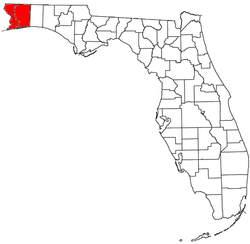Pace, Florida
| Pace, Florida | |
|---|---|
| CDP | |
 Location in Santa Rosa County and the state of Florida | |
| Coordinates: 30°35′57″N 87°09′41″W / 30.5992°N 87.1614°WCoordinates: 30°35′57″N 87°09′41″W / 30.5992°N 87.1614°W | |
| Country |
|
| State |
|
| County | Santa Rosa |
| Area | |
| • Total | 9.4 sq mi (24.3 km2) |
| • Land | 9.4 sq mi (24.3 km2) |
| • Water | 0 sq mi (0 km2) |
| Elevation | 66 ft (20 m) |
| Population (2010) | |
| • Total | 20,039 |
| • Density | 2,131.8/sq mi (824.7/km2) |
| Time zone | Central (CST) (UTC-6) |
| • Summer (DST) | CDT (UTC-5) |
| ZIP code | 32571 |
| Area code(s) | 850 |
| FIPS code | 12-53725[1] |
| GNIS feature ID | 0288352[2] |
Pace is a census-designated place (CDP) in Santa Rosa County, Florida, United States. The population was 7,393 during the 2000 census. It is part of the Pensacola–Ferry Pass–Brent Metropolitan Statistical Area. According to Pace CDP Census 2010 results, the population of the area was approximately 20,039 people. From 2000 to 2010, the Pace CDP population growth percentage was 171.1%.
Geography
According to the United States Census Bureau, the CDP has a total area of 9.4 square miles (24 km2), all land.
History
Pace is named after James G. Pace, who owned large lumber, paper and turpentine productions that operated in the Pace area and throughout the southeast.[3] Originally just a strip of land north of Floridatown, by the 1912 census, the area was known as Pace.[4] Afterward, Pace's growth was slow, and it remained a small, rural community throughout the last half of the twentieth century. Despite local efforts, incorporation failed at least once and has not been re-attempted recently. Within the last decade, however, growth has increased and Pace has become more suburban, surpassing its predecessors Floridatown and Pea Ridge in population and commercial activity. The small area still known as Floridatown became somewhat famous in 2004 when several homes were completely destroyed by Hurricane Ivan.
Demographics
| Historical population | |||
|---|---|---|---|
| Census | Pop. | %± | |
| 1970 | 1,776 | — | |
| 1980 | 5,006 | 181.9% | |
| 1990 | 6,277 | 25.4% | |
| 2000 | 7,393 | 17.8% | |
| 2010 | 20,039 | 171.1% | |
| source:[5] | |||
As of the census[1] of 2010, there were 20,039 people, 7,956 households, and 2,092 families residing in the CDP. The population density was 788.0 people per square mile (304.3/km²). There were 3,096 housing units at an average density of 330.0/sq mi (127.4/km²). The racial makeup of the CDP was 89.70% White, 1.80% African American, .9% Native American, 1.40% Asian, 0.10% Pacific Islander, 2.40% from other races, and 1.77% from two or more races. Hispanic or Latino of any race were 3.60% of the population.
There were 2,805 households out of which 37.6 percent had children under the age of 18 living with them, 56.4 percent were married couples living together, 13.9 percent had a female householder with no husband present, and 25.4 percent were non-families. 20.2 percent of all households were made up of individuals and 6.6 percent had someone living alone who was 65 years of age or older. The average household size was 2.64 and the average family size was 3.01.
In the CDP the population was spread out with 27.1 percent under the age of 18, 9.0% from 18 to 24, 30.8 percent from 25 to 44, 23.5 percent from 45 to 64, and 9.6 percent who were 65 years of age or older. The median age was 35 years. For every 100 females there were 95.9 males. For every 100 females age 18 and over, there were 91.3 males.
The median income for a household in the CDP was $36,538, and the median income for a family was $41,878. Males had a median income of $31,195 versus $21,648 for females. The per capita income for the CDP was $16,591. About 10.5 percent of families and 12.3 percent of the population were below the poverty line, including 13.5 percent of those under age 18 and 12.8 percent of those age 65 or older.
References
- 1 2 "American FactFinder". United States Census Bureau. Retrieved 2008-01-31.
- ↑ "US Board on Geographic Names". United States Geological Survey. 2007-10-25. Retrieved 2008-01-31.
- ↑ "Pace, Florida Information". US-FL: ePodunk. Retrieved 2012-12-18.
- ↑ "Pace . . . . A Historical Sketch". Friendsofpacelibrary.org. Retrieved 2012-12-18.
- ↑ "CENSUS OF POPULATION AND HOUSING (1790-2000)". U.S. Census Bureau. Retrieved 2010-07-31.
External links
- Santa Rosa Medical Center the primary provider of hospital-based healthcare services and emergency medicine in the Pace area

